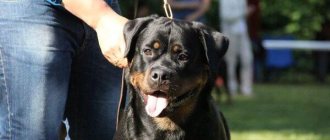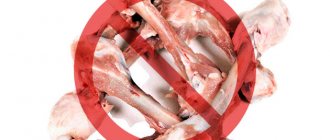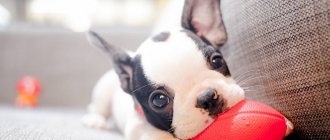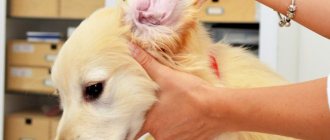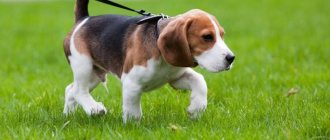If necessary?
Is it necessary and is it even possible to clean dogs’ ears? Of course yes! Wax accumulates in a dog's ears, and if you don't take care of them, then dirt also accumulates, which the animal is not able to clean out on its own.
It is necessary to clean your ears from time to time - this will protect against infections, fungus, inflammatory processes in the ears, diseases associated with the ears (for example, otitis media), as well as the proliferation of mites, which love to settle in delicate places.
In addition, the condition of your pet’s ears can be used to track a number of diseases in the early stages. If the ear turns red, the skin becomes irritated, swollen, and more wax is produced than usual, then this is a sign that it is time to visit the veterinarian.
Disgusting odor from dog's ears: quick cure strategy
How often?
How often you should clean your ears is not a simple question and there is no clear answer. The time between ear cleanings varies for different breeds. There are dogs that need to have their ears cleaned daily, while for others it is a rare, more preventative procedure. As in any matter, you need to know when to stop: if you clean an animal’s ears too often, you can destroy the natural protective microflora, and this is fraught with disease. The dog needs sebum and even a little sulfur to protect it from the outside world: temperature changes, dust.
How often you need to clean your ears will depend on:
- Ear lengths and shapes. The short standing ears are well ventilated and there is little dirt in them. But long, hanging ears, for example, like those of a basset hound, are not only a source of pride for the owner, but also an excellent “dust and dirt collector.” They sweat faster and dirt, sebum and wax quickly accumulate in them. Mites also often live on long ears.
- Wool lengths. The longer it is, the more frequent and thorough ear care is needed. Some, for example, a Yorkshire Terrier or a Chinese Crested, will also have to pluck the hairs in their ears - they will fall off in the ear canal and interfere with hearing and normal ventilation. This procedure is painless, but a little ticklish.
- How often does the dog go out for walks ? There is no place for your pet's ears to get especially dirty, and you can limit yourself to cleaning as natural contamination occurs - once a week or two.
- The age of the dog. The older the pet, the more careful and regular care it requires. How often should you clean your puppy’s ears? In fact, a puppy under 1 year of age may not need serious cleaning at all, but they need to be taught a list of grooming procedures. Even without direct need, you need to arrange regular procedures with your baby: run a comb over the body, touch the teeth, belly, examine the ears, claws.
So that your ears don't get dirty!
Every day you need to examine your pet's ears, regardless of breed. The auricle should be pink, warm and clean. The presence of an unpleasant odor or a squelching sound should alert you: this indicates an infection in the ear canal. In this case, it is better not to clean it yourself, but to contact a veterinarian.
The pet itself will indicate problems: it will begin to scratch its ear more often, and will squeal when trying to touch it. But it’s not worth starting before that.
Tip : to understand whether it’s time to clean your ears, carry out a simple test.
You need to moisten a cotton swab in water and gently rub the ear canal. A gray or yellowish coating formed on the stick indicates that so far everything is in order. But if a piece of sulfur comes out along with the stick, it’s time to carry out the procedure.
Importance of the procedure
Cleaning a dog’s ear is a disease prevention and a way to promptly detect disorders that require a veterinary examination and proper treatment. The appearance of an unpleasant odor is a signal of problems. It could be a mite, yeast-like fungi, or bacteria.
Expert opinion
Anna Abramenko
An avid dog lover. Experience in veterinary medicine since 2009.
Ask a Question
Cleaning your ears on time is important. The question concerns not only the aesthetic side, but also health. When a large amount of sulfur secretions accumulates, a dog may develop otitis media. Parasites are often associated with inflammation.
Cleaning products
How and what products can you clean your dog's ears with? One cotton swab is not enough to clean a dog’s ears; it must be moistened with something. What exactly depends on the condition of the animal. Warm water is enough for regular care, but don’t forget about modern products. They have a complex effect: they destroy bacteria, remove unpleasant odors and facilitate the cleaning procedure.
Lotions
A special cleansing lotion is an ideal product for monthly preventative cleaning. It cannot be used more often: lotions kill both harmful and beneficial bacteria, which makes the animal’s ears vulnerable to infections.
The benefit of lotions is that they contain special agents that dissolve dirt and sulfur. It’s enough to drop a couple of drops, lightly massage your ear, and all dirt will be shaken off.
You need to buy such a product at a veterinary pharmacy, having previously inquired about the manufacturer and composition. You may be allergic to low-quality cheap lotions.
It may contain:
- boric acid (for disinfection and softening of sulfur),
- salicylic acid (anti-inflammatory),
- malic acid (dissolves sulfur),
- oils (eucalyptus, tea tree), which disinfect and soften the skin,
- chamomile extract and aloe vera (regenerating agent).
Important : if it contains alcohol, you should not buy lotion.
There are dozens of lotions for cleaning dogs' ears. The most popular, but also the most expensive product is Otifree , made in France. You will need to pay almost 800 rubles for a bottle. Hartz (USA, 330 rubles) , Mr. Bruno (Russia-Switzerland, 150 rubles) and the budget Russian product Bars (100 rubles).
Hydrogen peroxide
Is it possible to clean your ears with something from a human pharmacy - hydrogen peroxide, for example? Cleaning dog ears with 3% hydrogen peroxide, iodine, cologne, vinegar or even vodka belongs to the category of dubious folk recommendations that it is better not to practice on your animal.
Of course, the product will disinfect the ear, but if you make a slight mistake with the dosage, cleaning with peroxide can cause severe burns . In addition, there will be nothing left of beneficial bacteria, and the skin will dry out.
So cleaning your ear with hydrogen peroxide is a bad and dangerous idea!
For comparison: any of the lotions, which are recommended to be used no more than once a month, have a more gentle composition. If there is nothing else at hand, it is better to rinse the auricle with ordinary warm water.
Chlorhexidine
Is it possible to clean ears with chlorhexidine? This solution is suitable for cleaning ears because... it is an excellent antiseptic and disinfectant, suitable for both people and animals. For your dog, you need to choose a chlorhexidine solution that says “For external use.” But this is a medicine that is not used just like that - only for inflammation, uncomplicated otitis, after consulting with a veterinarian.
You can also rinse the ears with a chlorhexidine solution for an adult animal that has been taken from the street. It is important to know that chlorhexidine does not tolerate the presence of anionic groups, soap, or alkalis, since in their presence it is inactivated. This means that you should not wash your ears with shampoo or anything else before using chlorhexidine.
Ear drops
A product that is similar in effect to lotions. In addition to the disinfectant, ear cleaning drops have an antipruritic and therapeutic effect; if there are wounds in the ears, they promote rapid healing.
There is a whole line of drops that fight ticks and heal scratched areas ( Aurican, Dekta, Otovedin, Otoferonol Premium ). The compositions of drops and lotions are very similar. Popular drops – Bio-Groom (USA, 1000 rubles), Bars (Russia, 100 rubles).
The drug costs 1000 rubles. contains boric acid, salicylic acid and eucalyptus oil. And although the drops are a medicinal drug that should be selected under the guidance of a veterinarian, and they cannot be used constantly, we advise you not to waste money and choose these drops. To some extent, the exception is the drug " Rosinka ", developed on the basis of herbs - St. John's wort, calendula and sage. It perfectly cleanses the ear canal, removes inflammation and swelling.
Before using the drops, you need to clear your ears of wax for the product to work. Putting drops into dirty ears is even harmful - the bacteria will gradually get used to the active substance, and it will be more difficult to remove them. You cannot drip cold drops, this will make the animal dizzy. First, warm them in your hands.
Gel
This product has a disinfectant effect, thicker than lotion. Gels appeared on the market not so long ago, and have not yet gained popularity among dog lovers. As a rule, the composition of the drug, created on the basis of water, contains herbal extracts, chlorhexidine, propolis. A definite plus is the absence of alcohol among the ingredients used.
If you choose between gel and lotion as a liquid for cleaning your ears, then it is better to choose the first one. It has fewer contraindications, the gel can be used more often, plus allergies rarely occur to it.
Artero gel based on tea tree oil is popular (Spain, 600 rubles).
Spray
It differs from gels and lotions mainly in the way it is used: it is sprayed rather than dripped into the dog's ear. On the one hand, it is easier, on the other hand, many animals are scared by the sound of the sprayer.
Sprays can be used once a week, which is also an advantage over lotions. You can start getting acquainted with sprays with the drug Auricap (Ukraine, 150 rubles), made on the basis of basil oil.
Powder
The powder is used to quickly clean the ears of healthy dogs. Great for long-eared breeds. It can also be a lifesaver if your pet is actively opposed to cleaning with a cotton swab.
It is enough to pour the powder inside the ear, holding the bottle at a distance of 2.5 cm from the auricle, wait a little and shake it off. Performs bactericidal and anti-inflammatory functions, dries out secretions and removes unpleasant odors.
There are powders that remove ear hairs - but you will need to rub them in with a cotton swab. You can use the powder once a week, but if it was prescribed by a veterinarian as a remedy, then every day.
When buying powder, you need to pay attention to the presence of iodoform - an antiseptic, it should be there. Bio-Groom Ear-Fresh (USA, 750 rubles), Espree EAR POWDER (USA, 750 rubles)
have proven themselves well
How to clean a dog's ears
There are a huge number of ear cleaning products available. It is very easy to get lost in this diversity. When choosing a dog ear cleaner, you should clearly understand how each of them works.
Special lotions and powders
Special lotions from veterinary pharmacies dissolve dirt and earwax, which is removed by massaging, with a dry cloth or by shaking the ears with the dog itself. Popular lotions include SaniPet, Trixie, Otifree, Ear Cleansing Liquid, Nutri-Vet, Iv San Bernard CLEAN EAR, Chris Christensen MYSTIC EAR and others.
For dogs belonging to long-eared breeds, it is recommended to use a special powder that has a drying effect. First you need to clean the ear with the product, and then apply the powder. It will improve ventilation in your ears, which will help prevent dirt buildup.
Pharmacy products
Lotions for cleaning dogs' ears can be replaced with medications that are sold at any pharmacy. These include:
- Hydrogen peroxide
. It is more convenient to purchase a bottle equipped with a pipette. Simply place a few drops in your dog's ear and then wipe them and any lather with a cotton pad.
- Chlorhexidine
. The solution has disinfectant properties. It is recommended to use it in case of wounds or other damage. Too frequent use of chlorhexidine provokes dry skin and dermatological diseases, so it is used only for healing purposes.
- Saline solution
. A small amount of the product is applied to a cotton pad and wiped over the ear. Saline solution is good for dogs with erect ears.
- Boric alcohol
. It is not recommended to use the product without a doctor's prescription. To administer alcohol, use a pipette, pour a few drops into each ear, then wipe them off with a cotton pad. Acts as a medicinal, and not as a hygienic, product; it is used for otitis of varying degrees of severity.
- Vishnevsky ointment
. Has an anti-inflammatory and healing effect. It is used if there are wounds and damage to the auricle.
- Miramistin
. It has a more gentle, but similar disinfecting effect.
Despite the widespread use of all of the above remedies, veterinarians do not recommend their use without indications. If you just need to clean your dog's ears, use a special lotion from a veterinary pharmacy.
Folk remedies
Folk remedies are widely used in veterinary medicine. If you urgently need to clean your pet’s ears, but you don’t have either peroxide or lotion on hand to clean the ears, then you can use folk remedies. The following infusions are suitable for this:
- chamomile;
- a line symbolically called a dog walker;
- mint;
- calendula;
- green tea.
You can use sea buckthorn, vaseline and other types of oils. A solution of sea salt, along with herbs, is considered an effective remedy; it cleanses earwax well and dries the surface of the animal’s ears. If you don’t have anything at hand, feel free to use tea leaves.
How?
- A cotton swab is the most common option.
The stick is soaked in a special lotion; it can also be used to rub powder and rub in drops. But for beginners, this is not the best option, because a stick can easily damage the animal’s delicate ear. Important : do not be afraid to rupture the eardrum: a dog’s ear is designed in such a way that it cannot be reached. - A cotton ball, dry or wet, works great for gentle ear care. It should be placed in the ear and gently rolled, cleaning all corners. The most important thing is to remember that the ball will still need to be taken out.
- A cotton pad is another alternative to a ball; there is not much difference between them. They can be used to gently remove dirt from inside the ear. But it will be difficult to manipulate a cotton pad on an irritable animal, because it is a slow process.
- Sanitary wipes for dog ears . This miracle remedy can be purchased at any veterinary pharmacy. They are already impregnated with a special composition that will dissolve dirt and sulfur. The wipes are great for emergency cleaning of the ears, for example, before a show, to give your pet a thorough cleaning. You can use them regularly, but it is much more expensive than a cotton ball.
What is the best way to clean the ears of a particular dog is difficult to say without trying. Most likely, it will be easier with a cotton ball or napkin, but it all depends on the character of the pet and the condition of the ears. Sometimes you will need the entire arsenal.
Ways to clean your ears
There are different techniques. The scheme is almost always the same, the only difference is in the means used.
Professional drugs
The pet store offers a wide range of lotions and gels for gentle care of dogs' ears. Each product comes with instructions, but the procedure is roughly the same.
Cleaning principle:
- pull back the ear;
- pour 2-3 drops of product into the sink;
- hold the dog so that it does not shake its head;
- perform a light massage for better distribution of fluid along the walls;
- After 2 minutes, wipe the inside of the ear with a cotton pad or swab treated with the same cleaning agent.
It is forbidden to immerse hard devices deep into the dog's ear. This risks damaging the eardrum and causing further problems.
Folk remedies
Chamomile infusion, string, mint, tea leaves, etc. are used. The instructions for use have one distinctive feature - the liquid is prohibited from pouring into the ear.
How to clean:
- Cool the prepared infusion to room temperature;
- Wipe the sink and ear canal with a dry cotton swab or disk;
- moisten another clean instrument in the prepared solution;
- treat the inside and hollows of the ear;
- wipe the sink dry.
What should you absolutely not do?
“Do no harm” - this rule of doctors is also effective for dogs. We have already discussed above why you should not clean your dog’s ears with alcohol-containing solutions and hydrogen peroxide. Children's lotions and soaps, although seemingly harmless, are not suitable for animals - they can cause allergies. You should also be wary of recommendations to rinse your ears with herbal tinctures without consulting a veterinarian.
To clean your ears, you should not take objects not intended for this purpose - wooden or plastic sticks, or gauze. During the cleaning process, the latter will leave strings that are difficult to remove from the ear. It is strictly forbidden to use matches and toothpicks - if the dog twitches even a little, the ear will be seriously injured.
How to do it right at home
Everything is prepared, it’s time to move on to the cleaning procedure. To do this you need:
- Choose a good time - when the animal is fed and calm. It is good if the procedure occurs immediately after washing the dog. There is no point in catching an excited dog around the house and restraining it by force - this can scare it, and later the procedure will be more difficult. So, if something goes wrong, it is better to temporarily abandon the cleaning procedure and return to it later.
- Secure the animal. First you need to command “Lie down”, then pet the dog, carefully lay it on its side. If the ear hangs, it is carefully lifted.
- Conduct an external inspection. If there is dried dirt, you should put drops or lotion in to soften it and wait a couple of minutes. You should not release the animal for this time - it will be more difficult to secure it a second time. It’s better to pet the dog and talk to it.
- When the dirt has partially dissolved, moisten a stick or cotton ball in lotion or warm water and thoroughly clean the ear. Do not rush or push the cleanser too deeply into the ear.
- Perform an ear massage - rub the cleaned ear with gentle movements. This will dissolve the remaining dirt, plus the dog will be pleased. She will be more relaxed about the procedure.
- Remove remaining sulfur and dirt. After a massage with a dry cotton swab, small particles of sulfur are removed and the ear canal is dried.
- If necessary, trim or pluck ear hairs.
- Praise the animal and release it with the command “Walk!” and watch him for a while. If it shakes its head, it’s okay, this is how the dog gets rid of the remaining lotion in his ears. By the way, if the dog wants to shake his head while cleaning, don’t bother him either.
The green area can be cleaned. You can't go into the red!
Advice : if the ears are long and very dirty, it is better to clean them one at a time, with breaks, maybe even at intervals of a day, otherwise it will be difficult for the dog to withstand.
It is important to remember that cleaning ears even at home is a kind of stress for your pet. You need to talk to him all the time, stroke him, maybe pat him on the back. It often takes four hands to thoroughly clean the ears (especially of long-eared breeds). In this case, it is worth calling someone from your family whom the dog knows and trusts, just like the owner. Otherwise, the pet will perceive this as “two for one”, and may harbor a grudge.
It is not worth holding the dog by force during cleaning - unless his life depends on ear procedures.
What to do if your dog won't let you clean your ears
If an adult dog does not allow its ears to be cleaned, then most likely the owner has made a number of mistakes while teaching the animal to the procedure. But everything can be fixed with desire and patience.
Since you will have to clean your dog’s ears at home regularly, it is important not to be nervous and to be as relaxed as possible with the animal every time. Call your dog as often as possible several times a day, just pet him on the head and give him a treat if he allows you to touch his ears. In this way, the dog will gradually become accustomed to examinations.
Next, the touches are replaced by lifting and massaging the ears. The next time you call, hold your hands on your pet’s ear a little longer, look inside, praise and let him go for a walk. Each subsequent training session adds time to examining the ear; you can gradually try to wipe the visible part of the auricle with a bandage without touching the ear canal. It is important to let the dog understand that ear cleaning is not scary, and after the manipulations there must be a treat.
If the dog leaves without allowing you to clean its ears, you cannot punish it physically: you can just show it, but not give it a treat. Any raised voice will form an unpleasant association with cleaning, so rude and stern tones are best avoided.
If your pet trusts you, he will willingly put his ears at your disposal. Therefore, the owner should try to do everything in a calm, friendly atmosphere, without intimidating. The dog must be in a good mood - after eating, immediately after washing, cleaning can be combined with other procedures (for example, grooming). For the first time, you may need an assistant.
In difficult cases, the dog does not allow you to brush your teeth and ears, cut your nails, or even wash yourself, because it does not recognize the person as a leader. Here, to achieve results, behavior correction is required - most likely, the effect will only come from classes with an instructor. As soon as the animal recognizes the person as the owner, problems with hygiene will disappear by themselves.
If it doesn't
What should you do if your dog categorically refuses to allow you to clean your ears? In theory, everything sounds good, but in practice, your pet may flatly refuse to clean its ears.
- Don't try to clean your ear right away . Let the pet first learn to trust its owner. To do this, you need to call him to you more often and, while maintaining eye contact, touch his ears and stroke them. Gradually, you can pay more and more attention to the ears: touch, massage, lift. Some stubborn breeds, such as terriers, will take a long time to get used to, but it will happen.
- You shouldn't have your ears cleaned at a veterinary clinic for the first time. Dogs remember negative emotions for a long time – and a visit to the veterinarian is usually one of them. In the future, it will be more difficult to persuade the animal.
- Never scold your dog for misbehaving during ear cleaning. There is no need to aggravate already bad feelings.
- When restraining the animal, do not squeeze it too hard - it will get scared and begin to instinctively try to free itself.
- Don't skimp on treats after the procedure. Before you start cleaning, you can show the animal a tidbit and let him know that he will soon get it (but this method will not work with impatient puppies; it is better to feed them constantly).
- Before purchasing a new ear cleaner, smell it. A sharp, unusual smell can scare even a quiet pet.
- If you can’t come to an agreement with your pet, you should put on a muzzle to protect your fingers.
Helpful Tips:
- You can shorten the cleaning procedure for dogs with long ears by not using cotton pads, but simply wrapping a damp cloth or napkin around your finger.
- The ears of small breed dogs cannot be cleaned from the inside with cotton swabs: the narrow ear canal will not be cleaned this way. But the opposite effect - thickening of earwax - is possible. The outside of such ears is cleaned with cotton wool, and the inside is washed with a syringe.
Rules for cleaning ears
The procedure is carried out extremely carefully. It is important not to cause pain or discomfort to the dog, so that in the future it behaves calmly and trustingly waits for the end of the cleaning.
Step-by-step instruction:
- Wash the animal so that it calms down and relaxes.
- While stroking and praising, lay the dog on its side.
- Carefully lift your ear up.
- Inspect all depressions. If there is dried dirt, it should be moistened with the selected softening agent.
- After applying the drops, lotion or other drug, massage. Gentle rubbing movements will dissolve the wax and remove it from your dog's ear canal.
- Remove the residue with a cotton swab or swab previously soaked in the product.
If he shakes his head after
- If the dog intensively shakes its head, scratches its ears on different surfaces (carpet, sofa upholstery, etc.), it means that something has gone wrong. It is likely that, due to your enthusiasm, when cleaning your ears, you got too deep into your ear and injured the ear canal. Often people do not clean out the sulfur, but compact it.
If after cleaning your dog shakes his head for a long time and diligently, then drop 2 drops of liquid, non-flavored and non-essential oil (olive, sunflower) into each ear and massage directly along with the ear canal (along the outside of the ear down and up).Do not stop the dog from shaking his ears, this will make his fate easier. If the injury is severe, then you need to buy ear drops that contain lidocaine or novocaine. They have a calming effect (this is a mild anesthesia).
- Nothing is injured, the dog just starts shaking his head to expel the solution from the ear canal.
- If dogs shake their heads after sleep, then most likely it’s just time to clean their ears!
Drops for otitis media
For the complex treatment of fungal otitis, drugs are prescribed that include miconazole, clotrimazole or nystatin.
The following anti-otitis drops for dogs are recommended for use:
- Surolan is an antimicrobial, anti-inflammatory and antiparasitic agent. You can use 3-5 drops twice a day. The course of treatment is 2-3 weeks.
- Aurizon fights bacteria and fungi. Apply 10 drops once a day for 1 week; if the symptoms do not disappear, the treatment is extended for the same period. Contraindicated for bitches expecting puppies.
- Otonazole is an antipruritic, antifungal agent. Use 3-5 drops once a day for 2 weeks.
- If the inflammation is caused by an allergen, antihistamine ear drops for dogs are used for otitis media.
- Sofradex – 2-3 drops, 3-4 times a day. Helps very well with swelling and itching.
- Anauran – 5 drops, 2-4 times a day. Indispensable for swelling and itching.
Treatment for suppurative otitis media in dogs is best done with antibiotic ear drops for dogs.
- Otibiovet – 4-5 drops. At the beginning of the development of the disease 3-4 times a day, after 3 days 2-3 times.
- Otipax – 4 drops, apply 2-3 times a day for ten days.
- Anandin , the dose here depends on the size of the pet. Dwarf breeds need 3 drops, medium breeds need 4 drops, and large breeds need 5 drops. The medicine is used for 3-4 days twice a day. It is required to repeat the course in a week, unless otherwise prescribed by your doctor.
The parasitic form requires treatment with insectoacaricidal agents.
- Leopard - 3 drops for dwarf dogs, 4 drops for medium-sized dogs and 5 drops for large dogs. Treatment is carried out twice with an interval of a week.
- Amitrazine is used once a day with an interval of 3 days. The procedure must be carried out until the signs disappear.
Otitis resulting from injury is treated with drugs that promote wound healing:
- Otopedin . Since these ear drops for dogs are quite toxic, the ears are treated once a week with 2-3 drops. After manipulation, the ears are fixed open for twenty minutes.
- Aurican needs to be dripped 5 drops for small dogs, 10-15 for medium-sized dogs, and 20 to 30 drops for large dogs. The drug is used daily for a week, then twice a week for another 25-30 days.
To make ear drops for dogs more effective, you need to follow some rules:
- Before the procedure, clean your pet’s ears;
- Warm the drops in the palm of your hand before use;
- when instilling, you need to pull the ear towards the spine, then press and massage a little.
Puppy
Until three months, the puppy is looked after by its mother, and it does not need hygiene procedures. But in order to avoid problems in the future, the baby needs to be taught a set of hygiene procedures: examining the ears, eyes, teeth, even if there is no need for this yet. The puppy must get used to the fact that the owner’s hands bring him only pleasure and benefit.
Starting from six months, you can start cleaning with a cotton ball. The procedure is no different from cleaning an adult dog. But it's best to do this in a game format.
Some breeds need thorough ear cleaning from childhood:
- York . How to properly clean a Yorkie puppy's ears? The ears of this breed require special attention because hair grows inside them. The puppy is taught to brush, apply lotion, remove hairs with tweezers and powder. This will need to be done every 2 weeks. Yorkies are smart and, having understood what the owner wants, will not become capricious. The main thing is not to scare.
- Labrador . How to clean a Labrador puppy's ears? The Labrador has delicate and rather large ears, and a rather stubborn character. That is why this breed begins to be trained from childhood. When cleaning the Labrador's ears, you need to be very persistent so that the dog understands that the time of hygiene procedures is determined by the owner. If the puppy struggles strongly, you should wrap it in a diaper (paws), but do not scream or hit.
- Spaniel . How to clean a spaniel puppy's ears? The beautiful ears of a spaniel are a source of problems for the owner. This is exactly the breed that really needs to have its ears cleaned almost from birth, because a small spaniel will collect all the dirt with its ears. The procedure is carried out as usual, plus it is worth plucking the hair on the inside of the ears if there is excess of it there.

